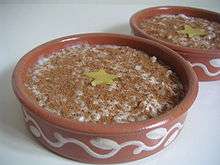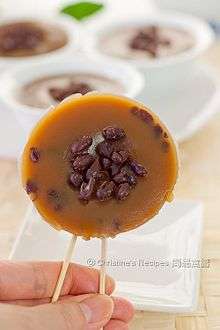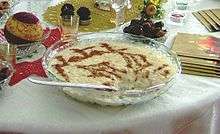Rice pudding
|
Risalamande being served during the traditional Scandinavian Christmas meal | |
| Alternative names | Arroz con leche, Riz au lait, Kheer |
|---|---|
| Type | Pudding |
| Main ingredients | Rice, water or milk |
|
| |
Rice pudding is a dish made from rice mixed with water or milk and other ingredients such as cinnamon and raisins. Different variants are used for either desserts or dinners. When used as a dessert, it is commonly combined with a sweetener such as sugar. Such desserts are found on many continents, especially Asia where rice is a staple.
Rice pudding around the world

Rice puddings are found in nearly every area of the world. Recipes can greatly vary even within a single country. The dessert can be boiled or baked. Different types of pudding vary depending on preparation methods and the ingredients selected. The following ingredients are usually found in rice puddings:
- rice; white rice (usually short grain, but can also be long grain, broken rice, basmati, or jasmine rice), brown rice, black rice
- milk; (whole milk, coconut milk, cream or evaporated)
- spices; (cardamom, nutmeg, cinnamon, ginger, etc.)
- flavorings and toppings; (vanilla, orange, lemon, rose water; pistachio, almond, cashew, raisin, walnut, etc.)
- sweetener; (sugar, brown sugar, honey, sweetened condensed milk, dates, fruit or syrups)
- eggs (sometimes)
The following is a list of various rice puddings grouped by place of origin.
Middle East and North Africa
- Moghli (Lebanese) with anise, caraway, and ginger
- Muhalibiyya (Arabic) with milk, rice flour, sugar, and rosewater
- Pudding Orez (Israel, פודינג אורז) flavored with rosewater and sometimes also flavored with cinnamon and raisins on top
- Riz bi haleeb (Eastern) or ruz bil-laban (Egyptian), (lit. "rice-with-milk") with rosewater and occasionally mastic
- Zarda wa haleeb (Iraqi) rice prepared with date syrup served in the same dish as with rice prepared with milk
Asia


Many dishes resembling rice pudding can be found in Southeast Asia, many of which have Chinese influences. Owing to Chinese usage, they are almost never referred to as rice pudding by the local populations (whether ethnic Chinese origin or not) but instead called sweet rice porridge. The term "pudding" in various modern East Asian languages denotes a cornstarch or gelatin-based jelly-like set dessert, such as mango pudding. The rice pudding dishes that follow are explicitly referred to as such by the originating cultures.
- Banana rice pudding (Cambodian)
- Bubur Sumsum (Indonesian)
- Ketan hitam (Indonesian) black glutinous rice porridge
- Tsamporado[1] (Philippines) chocolate rice pudding
- Dudhapak (Indian(Gujarati)) with slow-boiled milk, sugar, basmati rice, nuts, and saffron
- Firni (Tajik/Afghan/Indian/Pakistani/Bangladeshi) with broken rice, cardamom and pistachio, reduced to a paste, and served cold
- Kheer (Indian Subcontinent) with slow-boiled milk
- Kiribath (Sri Lankan) made with coconut milk
- Put chai ko (Hong Kong) made with white or brown sugar, long-grain rice flour with a little cornstarch.
 缽仔糕 Hong Kong Steamed Bowl Rice Pudding
缽仔糕 Hong Kong Steamed Bowl Rice Pudding - Payasam (South Indian) with slow-boiled milk, sugar/jaggery, and nuts
- Phinni/Paayesh (Bengali) with grounded basmati or parboiled rice, cardamom and pistachio; can be served either hot or cold
- Pulut hitam[2] (Malaysian/Singaporean) similar to ketan hitam, its Indonesian counterpart
- Shir-berenj/ (Tajik, Afghan, and Iranian)
- Shola-e zard (Tajik, Afghan, and Iranian) with saffron
- Şorbeşîr (Kurdish) with cinnamon
Canada and the United States
In Canada and the United States, most recipes come from European immigrants. In the latter half of the twentieth century, Asian, Middle Eastern, and Latin American recipes have also become more common. In New England, a popular pudding is made with long grain rice, milk, sugar, or in Vermont, maple syrup. This may be combined with nutmeg, cinnamon, and/or raisins. The pudding is usually partially cooked on top of the stove in a double boiler, and then "finished" in an oven.
Europe



- Arroz con leche (Spanish) with milk, sugar, cinnamon and lemon zest (some recipes use the lemon zest whole which is removed before plating, other recipes use grated lemon zest.)
- Arroz doce (Portuguese) with rice, sugar, milk, eggs, cinnamon and lemon peel
- Arroz-esne (Basque) with rice, sugar and milk; sometimes with cinnamon.
- Budino di riso (Italian) with milk, eggs, raisins and orange peel
- Grjónagrautur (Icelandic), everyday meal, served with cinnamon, sugar and raisins.
- Milchreis (German) with rice, milk, sugar, cinnamon, apple sauce, roter Grütze or cherries
- Mlečni riž or Rižev puding (Slovene)
- Mliečna ryža (Slovak)
- Ryż na mleku (Polish)
- Молочна рисова каша (Ukrainian), also can appear as кутя (Kutia) for Christmas (served with dried fruits and nuts)
- Orez cu lapte (Romanian) with milk and cinnamon
- Sutlijas (Montenegrin)
- Rijstebrij (Dutch) or Rijstpap (Flemish)
- Riz au lait (French)
- Riža na mlijeku (Croatian)
- Ρυζόγαλο (ryzogalo, Greek) with milk, sugar, vanilla and cinnamon[3][4]
- Sütlaç (Turkish), served as cold; often browned in a salamander broiler and garnished with cinnamon. May be sweetened with sugar or pekmez.
- Sutlija (Bosnian)
- 'Сутлијаш or Благ ориз (Macedonian), also Лапа (lapa,
 Audio ) with black poppy seeds
Audio ) with black poppy seeds - Сутлијаш / Sutlijaš (Serbian)
- Сутляш or Мляко с ориз (mljako s oriz) (Bulgarian) with milk and cinnamon
- Sylt(i)jash or Qumësht me oriz (Albanian)
- Tameloriz (Kosovan Albanian)
- Teurgoule (Normandy)
- Tejberizs (Hungarian) with raisins, cinnamon and/or cocoa powder
- Рисовая каша (Risovaya kasha) (Russian), usually eaten for breakfast, sweetened with sugar and served with a knob of butter.
- Risgrynsgröt (Swedish), served with sugar and cinnamon and milk or fruit juice sauce, at the Christmas table and for breakfast and dinner during the winter months, especially during Christmas time
- Risengrød (Danish), served with butter, sugar and cinnamon or dark fruit juice at the Christmas table and for dinner during the winter months
- Risengrynsgrøt (Norwegian) especially popular at Christmas
- Riisipuuro (Finnish), served at Christmas time, often with cinnamon and sugar. Additionally used as a filling for the traditional Karelian pasty.
Nordic countries

In the Nordic countries, rice porridge is a common breakfast, and sometimes dinner. It is made as a warm dish from rice cooked in milk. When served, it is commonly sprinkled with cinnamon, sugar and a small knob of butter, and served with milk or fruit juice. In Iceland, it is sometimes served with cold slátur, a type of liver sausage. In different languages it is called risengrød (Danish), risengrynsgrøt (Norwegian), risgrynsgröt (Swedish), riisipuuro (Finnish), grjónagrautur, hrísgrautur or hrísgrjónagrautur (Icelandic), and rísgreytur (Faroese).
The rice porridge dinner is used as a basis for rice cream dessert. There are many different variants of this dessert but the basis is the same: cold rice porridge (the dinner variant) is mixed with whipped cream and sweetened. In Sweden, it is sometimes mixed with oranges and is then called apelsinris. Risalamande (Danish, after French riz à l'amande, rice with almonds) is cold risengrød with whipped cream, vanilla, and chopped almond, often served with hot or chilled cherry (or strawberry) sauce. In Norway, the dessert is called riskrem and sometimes served with red sauce (usually made from strawberries or raspberries). Rice cream dessert is called ris à la Malta in Sweden, while what is referred to as risgrynspudding is made with eggs instead of cream.
In Scandinavia, rice pudding has long been a part of Christmas tradition, in some countries referred to as julegröt/julegrøt/julegrød/joulupuuro (Yule porridge) or tomtegröt/nissegrød. The latter name is due to the old tradition of sharing the meal with the guardian of the homestead, called tomte or nisse (see also blót). In Finland it is common to eat the Christmas rice porridge with a sauce made of dried prunes.
A particular Christmas tradition that is often associated with eating rice pudding or porridge is hiding a whole almond in the porridge. In Sweden and Finland, popular belief has it that the one who eats the almond will be in luck the following year. In Norway, Denmark, Iceland and the Faroe Islands, the one who finds it will get the almond present as a prize. In Denmark and the Faroe Islands, the almond tradition is usually done with risalamande served as dessert at Julefrokost (Christmas lunch) or on Christmas Eve. In Norway, it is commonly served as lunch or early dinner on Christmas Eve or the day before, lillejulaften ("Little Eve"). In Sweden and Finland, it is more commonly done with a rice porridge dinner, sometimes a few days before Christmas Eve.
United Kingdom
In the United Kingdom, rice pudding is a traditional dessert and is very popular, though not universally so:
What is the matter with Mary Jane?
She's perfectly well and she hasn't a pain,
And it's lovely rice pudding for dinner again![5]
The earliest rice pudding recipes were called whitepot and date from the Tudor period; one of the earliest recipes was written down by Gervase Markham in 1615.[6] Rice pudding is traditionally made with pudding rice, milk, cream, and sugar and is sometimes flavoured with vanilla, nutmeg, jam and/or cinnamon. It can be made in two ways: in a saucepan or by baking in the oven.
In a saucepan, it is made by gently simmering the milk and rice until tender, and then the sugar is carefully mixed in. Finally, the cream is mixed in, and it can either be left to cool and be served at room temperature, or it can be heated and served hot. It should have a very creamy consistency.

When made in the oven, the pudding rice is placed into a baking dish, and the milk, cream and sugar are mixed in. The dish is then placed in the oven and baked at a low temperature for a few hours, until the rice is tender and the pudding has a creamy consistency. While cooking, the pudding may develop a thick crust, which adds an interesting texture to the pudding.
An alternative recipe frequently used in the north of England uses butter instead of cream, adds a small pinch of salt, and requires the pudding mixture to stand for an hour or so prior to being cooked. Such puddings tend to set firmly when cooled, enabling slices to be cut and eaten like cake. If eaten hot, the pudding is traditionally served with cream poured on top in wealthy households, and with full fat milk where cream was not available. A spoonful of sweet jam or conserve is also a very popular topping for the pudding.
A specific type of rice is available and widely used for rice pudding called "Pudding Rice". Similar to Arborio rice, its grain is round and short, and when cooked produces a creamier consistency than savoury rice. However, short grained rice such as risotto rice can be used as a substitute.
Ready-made, pre-cooked rice pudding sold in tin cans or pots is very widely available in most supermarkets and shops. Because it is canned, it has a very long shelf life. The most popular brand is Ambrosia.
Latin America and the Caribbean

- Arroz con dulce (Puerto Rican) Puerto Rican rice pudding is made with pearl rice. The rice is first rinsed until the water is clear and most of the starch has been removed, then it is left over night in water (this process makes it easier to cook and gives the rice better texture). Coconut milk, cream of coconut, evaporated milk, cloves, ginger, raisins (soaked in rum), vanilla, cinnamon, sugar, nutmeg and the option of lemon zest is simmered until the coconut milk is infused with all spices. The rice is then drained and place in a hot pot that has been coated in butter. The infused coconut milk is then poured on the rice and cooked until rice is tender and sticky. Coconut milk and cream can be replaced with more milk and cream cheese; pistachios can be substituted for raisins. Puerto Rican rice pudding is also popular in Colombia and Venezuela.
- Arroz con leche (Dominican Republic) made with milk, cinnamon, raisins, sugar, and lemon zest.
- Arroz con leche (Nicaragua, Argentina, Paraguay, El Salvador, Chile, Costa Rica, Cuba, Panama, Uruguay, Venezuela) made to Spanish recipes; popular flavourings include anise seed, star anise, and raisins.
- Arroz con leche (Mexican) with milk, cinnamon, sugar, egg yolk, vanilla, orange peel, raisins (soaked in sherry, rum or tequila); chocolate, butter, nutmeg, or lime zest may also be added.
- Arroz en leche (Guatemala) with milk, cinnamon, sugar, and vanilla; raisins may also be added.
- Rice pudding (Jamaican) with milk, egg yolk, allspice, sugar, raisins (soaked in rum), vanilla, butter, sometimes crushed meringue, toasted coconut flakes, cornstarch, and crushed pineapple can be added.
- Arroz con leche (Colombian) with milk, cream, sugar, coffee, raisins (soaked in rum or red wine), butter, vanilla, cinnamon, and cloves
- Arroz con leche (Peruvian) with milk, sugar, orange peel, raisins, cloves, sweetened condensed milk, cinnamon, and vanilla and sometimes shredded coconut and (more rarely) brazil nuts can be added. It is commonly consumed with mazamorra morada (purple corn pudding). When served with it is known as "clasico".
- Morocho (Ecuador)
- Sweet rice (Trinidadian and Guyanese) with coconut milk, nutmeg, cinnamon, raisins, vanilla, and angostura bitter
- Arroz-doce or Arroz de leite (Brazilian) with milk, coconut milk, sour cream, sugar, condensed milk and cinnamon.
In popular culture
Buddhist Sutras state that Gautama Buddha's final meal before his enlightenment was a large bowl of rice pudding, prepared for him by a girl named Sujata.
Rice pudding is mentioned frequently in literature of the Victorian and Edwardian eras, typically in the context of a cheap, plain, familiar food, often served to children or invalids, and often rendered boring by too-frequent inclusion in menus.
In Edward Bulwer-Lytton's Kenelm Chillingly, a would-be host reassures a prospective guest: "Don't fear that you shall have only mutton-chops and a rice-pudding ...". In Henry James' A Passionate Pilgrim, the narrator laments: "having dreamed of lamb and spinach and a salade de saison, I sat down in penitence to a mutton-chop and a rice pudding."
Charles Dickens relates an incident of shabby treatment in A Schoolboy's Story: "it was imposing on Old Cheeseman to give him nothing but boiled mutton through a whole Vacation, but that was just like the system. When they didn't give him boiled mutton, they gave him rice pudding, pretending it was a treat. And saved the butcher."
In Ethel Turner's Seven Little Australians, the children express dissatisfaction with their food. "My father and Esther ... are having roast fowl, three vegetables, and four kinds of pudding", Pip says angrily. "It isn't fair!" His sister notes that "we had dinner at one o'clock." "Boiled mutton and carrots and rice pudding!" her brother replies, witheringly.
In Jane Austen's Emma, reference to the combination of mutton and rice pudding is once again made - "... his two eldest boys, whose healthy, glowing faces shewed all the benefit of a country run, and seemed to ensure a quick despatch of the roast mutton and rice pudding they were hastening home for."
Rice Pudding is the title and subject of a poem by A. A. Milne, in which the narrator professes puzzlement as to what is the matter with Mary Jane, who is "crying with all her might and main/And she won't eat her dinner—rice pudding again—/What is the matter with Mary Jane?"
T.S. Eliot, in the poem "Bustopher Jones: The Cat About Town," writes: "If he looks full of gloom/Then he's lunched at The Tomb/On cabbage, rice pudding, and mutton."
Rice pudding is mentioned with much more affection in an incident related by Walt Whitman in Specimen Days. Whitman visited an invalid soldier who "was very sick, with no appetite ... he confess'd that he had a hankering for a good home-made rice pudding—thought he could relish it better than anything ... I soon procured B. his rice pudding. A Washington lady, (Mrs. O'C.), hearing his wish, made the pudding herself, and I took it up to him the next day. He subsequently told me he lived upon it for three or four days."
In the play Arcadia by Tom Stoppard, Thomasina Coverly uses the example of stirring jam into rice pudding as an illustration of chaos. She wonders why it isn't possible to separate the jam from the pudding by stirring backwards. Her tutor Septimus Hodge asserts that it is because our universe is deterministic, according to the theories of Isaac Newton.
In The Hitchhiker's Guide to the Galaxy by Douglas Adams the supercomputer Deep Thought derives the existence of rice pudding from first principles. This is to counterpoint between the complexity of Deep Thought and its task of exploring the eternal verities, with simplicity of the pudding.
See also
Notes
- ↑ Almario, Virgilio, et al. 2010. UP Diksiyonaryong Filipino, 2nd ed. Anvil: Pasig.
- ↑ "Bubur Pulut Hitam (Black Glutinous Rice dessert)". A Table For Two. Retrieved 2014-03-12.
- ↑ "Greek Style Rice Pudding (Rizogalo)". Thursdayfordinner.com. 2009-09-29. Retrieved 2014-03-12.
- ↑ Hadjittofi, Petroula. "Ρυζόγαλο". foodmuseum.cs.ucy.ac.cy (in Greek). Cyprus Food Virtual Museum. Retrieved 27 November 2015.
- ↑ A. A. Milne, "What is the matter with Mary Jane?"
- ↑ Historical Foods Whitepot Recipe 1615
References
- "Living on a Small Salary". The New York Times. 4 August 1884. p. 2.
- Ozan, Ozcan (2001). The Sultan's Kitchen. Periplus Editions. ISBN 962-593-223-2.
- Candleshoe. Walt Disney Pictures. 1978. ISBN 0-7888-5158-6.
External links
| Wikimedia Commons has media related to Rice puddings. |
| Wikibooks Cookbook has a recipe/module on |
- History of Puddings at Food Timeline

